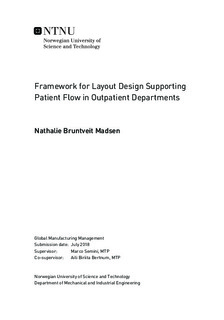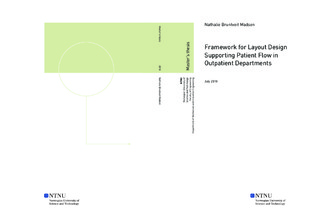| dc.description.abstract | In the last decades, there has been an increase in demand for outpatient services, as inpatient treatments are more often done on an outpatient basis. Increase in demand, and long waiting times in the access of outpatient services, is a concern in several countries, whereas waiting time is an important indicator on availability and quality in health care services. In addition, literature concerning layout and patient flow in outpatient departments are scarce. A proper layout is important in realizing efficiency in the production of services, as layout directly affects the performance of a process. The main objective of layout is to ensure efficient flow, whereas improving patient flow can allow for serving more patients. In addition, long walking distances for patients exposes the patients for risk of adverse effects.
The objective of this master s thesis is to study patient flow in outpatient departments, and how layout can support patient flow, to develop a framework for layout design supporting patient flow in outpatient departments. Supporting patient flow is to facilitate high patient throughput volume, short patient throughput time, low patient waiting time, high personnel utilization, low personnel overtime, and short travel distances for patients and personnel. To answer the objective, the following research questions are answered to provide the groundwork needed to develop the framework:
RQ1: What are the characteristics of patient flow in outpatient departments?
RQ2: How can layout support patient flow?
The research design of the master s thesis consists of a literature study to find relevant research, combined with a case study including three orthopedic outpatient departments. The aim of the literature study is to answer the research questions, and to answer the research objective by developing a preliminary framework. The aim of the case study is to provide additional insight to the topics studied. The development of a revised framework is based on the information gathered in the literature and case study combined.
Patient flow in outpatient departments can take place either within one outpatient department, or multiple departments of a hospital. Patients move to registration and waiting areas, and to the departments and rooms where they are to receive consultations. Patients may undergo one or multiple consultations during a visit to the hospital. The components of a system that affects patient flow are available capacity and variability. Regarding available capacity, health personnel, especially doctors are bottleneck resources, that determines the throughput volume of an outpatient department.
The relative location of registration areas, waiting areas, rooms, and departments affects how the patient flows throughout a hospital facility. Concerning how layout can support patient flow, the components of layout that can affect the patient flow to be considered are: length of flow, clarity of flow, predictability of flow, flexibility, and coordination capabilities. The different components more or less concern length of flow, whereas reducing the length of flow for patients reduces risk of adverse effects and allow for shorter throughput times. For health personnel, reducing length of flow allows for more time spent on care, and facilitates communication, coordination, teamwork and productivity.
The result of the master s thesis is a framework for layout design supporting patient flow in outpatient departments. The framework provides a structured overview, and entails a definition of patient flow and layout, components of a system and of a layout that can affect the patient flow, and how layout should support the patient flow in outpatient departments. The framework can be used as a support in layout design of future hospital buildings, with emphasis on supporting outpatient department flow. The framework may also be used for other patient flows in hospitals, as the framework presented is mainly based on general layout objectives. | |

